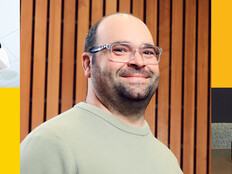Improve Learning by Offering a Blend of Online and Face-to-Face Courses
The University of Central Florida first began offering online classes to reach students who couldn't get to campus.
But then program assessors discovered that 75 percent of UCF's "distance-learning students" lived on campus. Why were they taking courses online? When asked, the students explained that they liked the freedom and flexibility of taking some of their courses online.
Armed with that information, the Orlando-based university began offering all students online and blended courses, which combine face-to-face and online instruction. That was 15 years ago, and UCF hasn't been the same since.
The shift to mixed classroom and digital learning environments, along with growth on campus, has allowed UCF to expand its student body so much that last year it became the nation's largest university based on enrollment.
It's a success story that Vice Provost and CIO Joel Hartman shares with caution. When he hears colleagues talk about wanting to make money from blended learning – as he often does – Hartman talks them down.
"Getting into online learning to make money is the worst reason to get into it," he says.
The best reason? Simple: It improves learning. When UCF started offering blended courses, there was little data about their effectiveness. So the school created its own research unit, which has consistently found that blended learning works as well as or better than other modes of education in terms of student success and retention.
That's echoed in studies at colleges around the country, says Gartner analyst Marti Harris. "It's not just an alternative way," she says. "It's an improvement when greater focus is on how to best use the face-to-face time."
The success stories are so ubiquitous that it's hard to find universities that don't offer some hybrid courses. "Blended learning is going to become so pervasive that we'll probably lose the term 'blended learning,' " Harris says. "This is how we teach and learn now, even in courses that aren't officially labeled as 'blended.' "
8 Tips for Creating a Perfect Blend of Online and Face-to-Face Courses. Click to read more.
A Pleasant Surprise
Before teaching her first blended class, Karen Teeley, assistant professor of nursing at Simmons College in Boston, was worried that she would lose her voice – that she wouldn't have enough face time to form connections with her students. But she had the opposite experience.
"I heard all of the students' voices," she says, "where in a classroom, you only hear one or two people – you know, the people who raise their hands and speak out freely."
Teeley is one of several professors who shared their experiences in case studies on Simmons' blended learning site (at.simmons.edu/blendedlearning). They speak about how they are more creative in their teaching, engage students more effectively and have gained valuable feedback on the effectiveness of their instruction through quick online assessments.
Enrollment figures suggest that students are equally impressed. Online and blended classes account for 18 percent of course sections at UCF. "It's growing at double-digit rates," Hartman says.
In a traditional environment, the university would need to add about 8,000 square feet of classroom space each year to keep up with such growth. But a blended class that meets two or three times a week can meet once a week in a classroom and the remainder of the time online. That way, multiple courses can be scheduled in one classroom time slot.
"It's allowed us to grow faster than our ability to build classroom space to grow into," Hartman says.
Blended learning also expands the reach of colleges because it's accessible to students who live far away or who work during school hours, adds Bill Wisser, instructional designer for Simmons College's Department of Academic Technology. The Doctorate in Nursing Practice program, in which every class has both an online and a face-to-face component, has students from throughout the region.
One important benefit of blended learning is increased communication. Discussion boards, web conferencing, blogs, e-portfolios, podcasts and social media let even the quietest students contribute to the class discussion.
During her junior year of high school, Amy Sigle took an English 101 class at Cascadia Community College in Bothell, Wash. The class met for two hours a week in person. And the professor posted assignments and discussion board questions online that required a response from the students.
"If you're a shy student, the discussion board definitely lets you have your say," the soft-spoken Sigle notes.
Now a junior at Western Washington University in Bellingham, Sigle says she would definitely take another blended course, but not in her major, English literature. She likes the convenience of online classes, but she prefers face-to-face interaction when it comes to subjects in which she has a strong interest.
"I liked it a lot," she says of blended learning. "It's better than an online class, because you still have a relationship with the professor."
Adds Simmons' Wisser, "It combines the best of both worlds."
Engaging Your Faculty
Who wouldn't want the best of both worlds? Some faculty members, surprisingly.
Getting faculty to engage in blended learning is one of the chief challenges, Gartner's Harris says. Only 20 percent of faculty actively participate in their institutions' e-learning environments, she says.
At Simmons, 25 percent of full-time faculty completed the college's weeklong blended-learning training institute, which it created with a $225,000 grant from the Alfred P. Sloan Foundation. Their classroom experiences were a mixed bag, Wisser says. Some loved it and found that it brought new life to their courses, while others thought it was a lot of work for few additional benefits.
"It takes a little while to get comfortable doing it," Wisser says. The entire course has to be fully envisioned and outlined up front, and it requires extensive technology training.
Faculty and students incorrectly assume that online classes are easier, adds Mike Simmons, senior associate director of the Center for Learning Enhancement, Assessment and Redesign at the University of North Texas.
"They really aren't. They are harder to deliver, and the courses are harder for students," says Simmons, who adds that the Denton, Texas, university has offered blended courses since the 1990s. "They require greater self-discipline."
4.5% Percentage of blended course sections at the University of Central Florida; accounting for 18% of all course sections and 30% of credit hours when combined with online-only courses
The Simmons faculty who complete the institute are assigned an instructional designer and an instructional technologist who offer one-on-one support as they build their blended learning courses. But that poses another challenge: technical support. The Academic Technology Department at Simmons has been down three full-time positions since fall 2009.
"So we're having to do more with less," says Wisser, who teaches at the institute and spends about 20 hours consulting with every professor who teaches a blended course.
At UNT, Simmons faces similar challenges. Blended courses should meet state and national standards of quality, and that requires collaboration between faculty, the IT department, instructional designers and administrators, he says.
Plus, blended learning has created a 24x7 learning environment, which has also challenged his team in terms of support. "The assumption is that blended learning costs less," he says. "But what we've found is it costs different."
Digital Helping Hands

- Sloan-C training programs (sloanconsortium.org/certificate and sloanconsortium.org/blended): information about online teaching certification, annual conferences and workshops provided by the Sloan Consortium
- Quality Matters, by MarylandOnline (qmprogram.org/new-website-welcome-page): a national peer-review process that certifies the quality of online classes
- EDUCAUSE's Blended and Online Learning site (educause.edu/cg/blend-online): provides links to research and information as well as wikis and discussions for IT managers at colleges and universities
- University of North Texas Center for Learning Enhancement, Assessment, and Redesign (clear.unt.edu): offers ideas, resources and statistics on online teaching
- Simmons College's Blended Learning site (at.simmons.edu/blendedlearning): details the school's program and offers tools, case studies and more
- Blended Learning Toolkit (blended.online.ucf.edu): from the University of Central Florida and the American Association of State Colleges and Universities; includes information on building and evaluating courses, professional development and research







